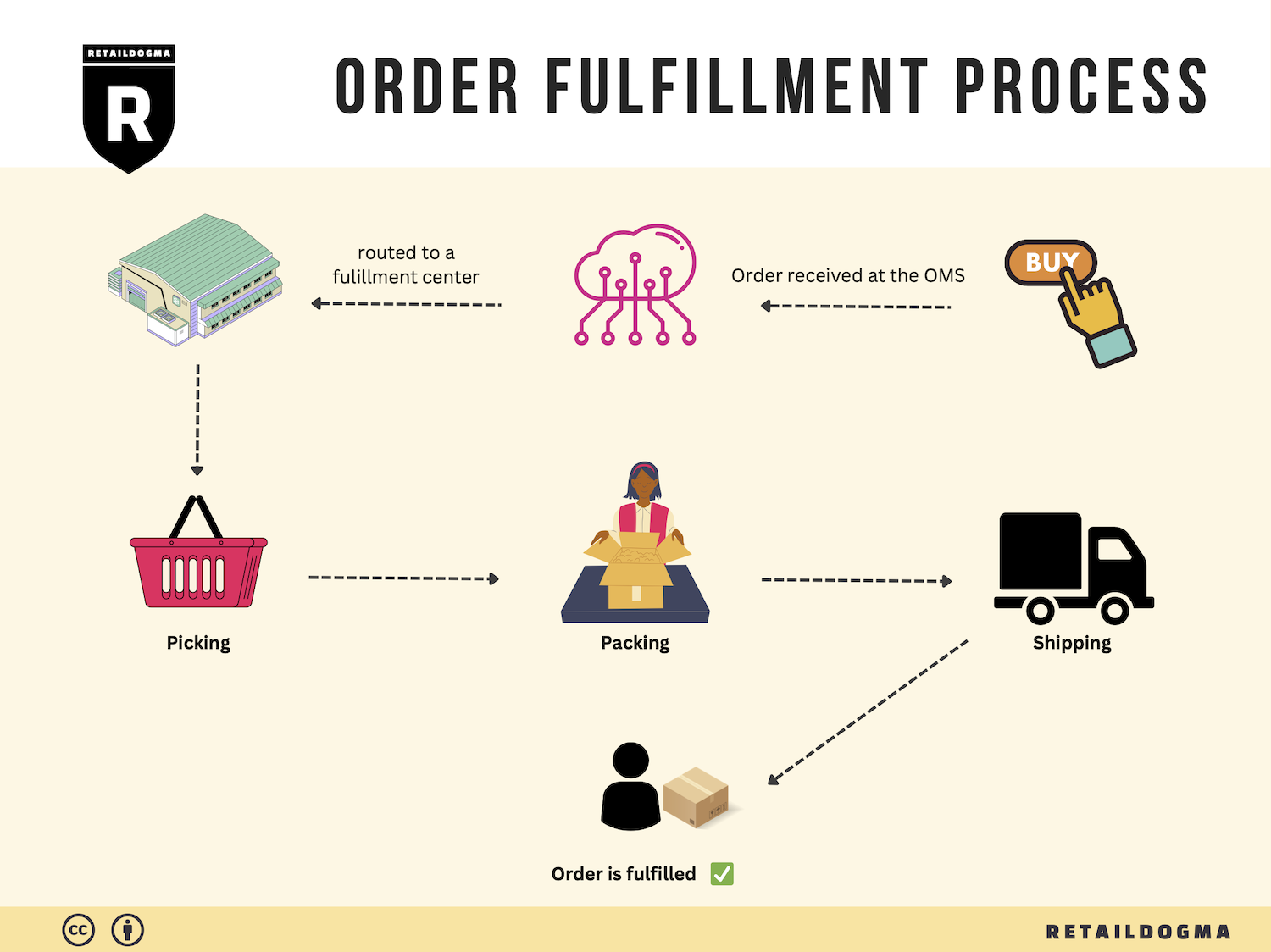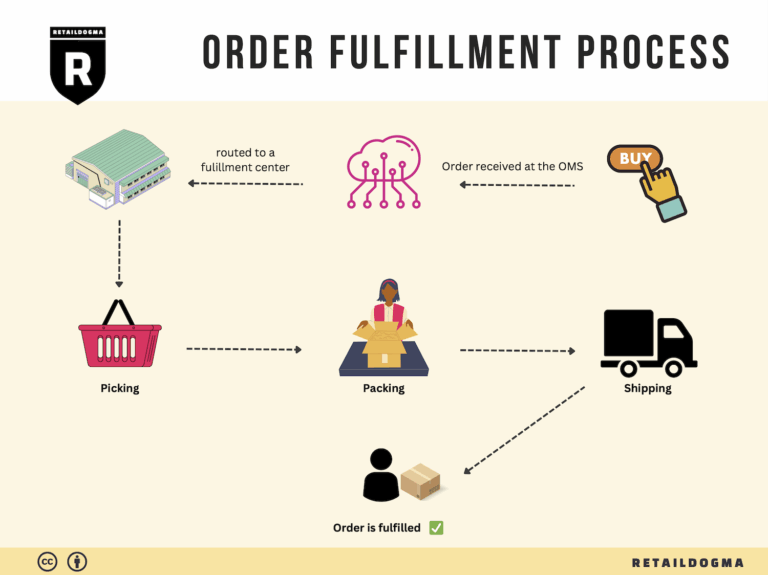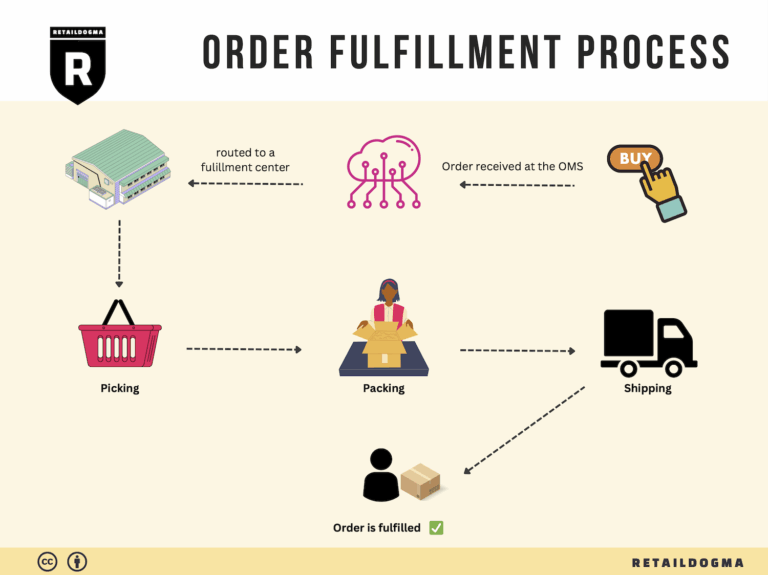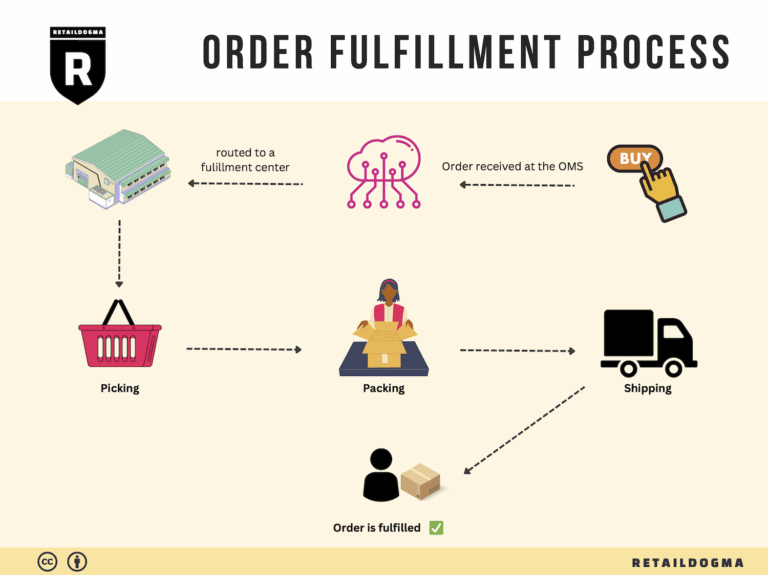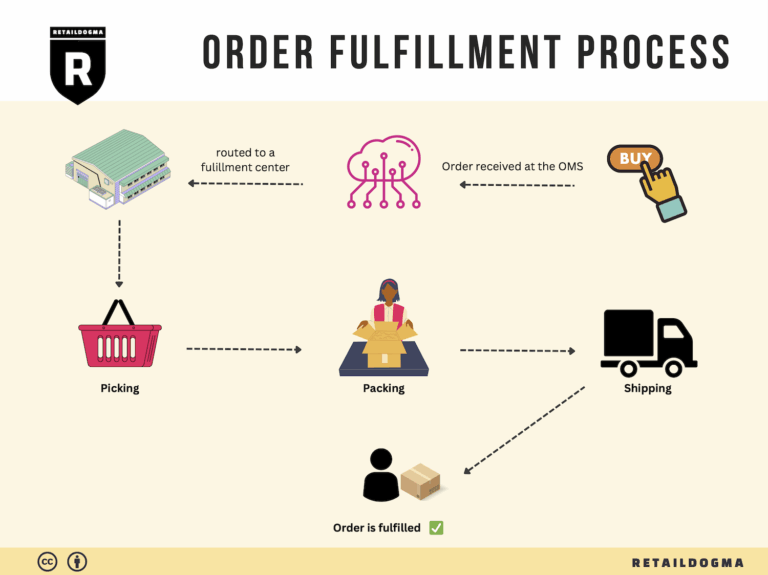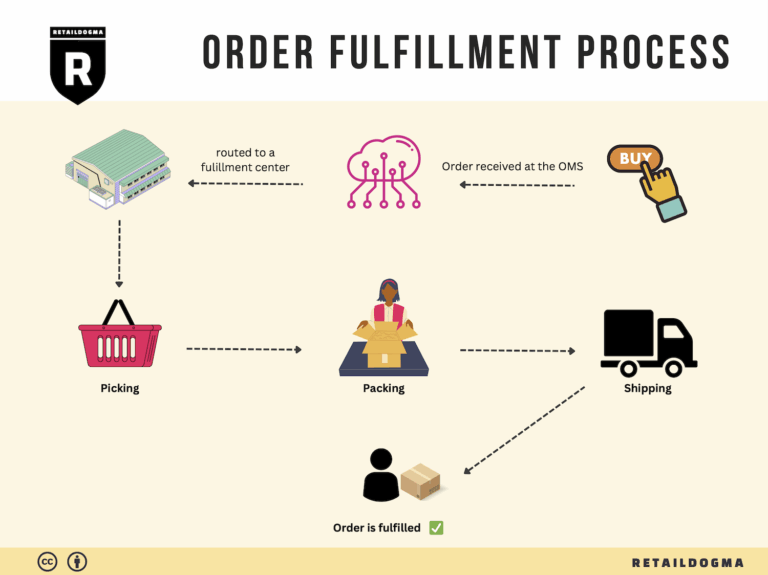What Is A Fulfillment Center? A Complete Guide (2025)
What is E-commerce Fulfillment? An Introduction for Growing Businesses
Understanding E-commerce Fulfillment
As a growing online business owner, you may find yourself grappling with the complexities of packing and shipping orders. It’s a common pain point: managing inventory, ensuring timely deliveries, and maintaining customer satisfaction can quickly become overwhelming. In the competitive landscape of e-commerce, efficient fulfillment is crucial not only for operational success but also for building customer loyalty.
Fulfillment, at its core, refers to the entire process of getting a product from your warehouse to your customer’s doorstep. This process encompasses receiving inventory, storing products, picking and packing orders, and finally shipping them out. Mastering fulfillment can significantly impact your bottom line, as it directly affects shipping costs, delivery times, and ultimately, customer experience.
This guide aims to demystify the various aspects of e-commerce fulfillment to help you make informed decisions as your business scales. We will explore different fulfillment models, including Third-Party Logistics (3PL) and Fulfillment by Amazon (FBA), each offering unique advantages and challenges. Understanding these models is essential for determining which aligns best with your operational needs and growth strategies.
Additionally, we will delve into core fulfillment services that are vital to efficient operations, such as inventory management, order processing, and returns handling. Choosing the right fulfillment partner can make or break your logistics strategy. We will provide insights on what to look for in a partner, including their technology capabilities, geographical reach, and customer service standards.
Pricing is another critical element of fulfillment that often leaves business owners scratching their heads. We will break down the various pricing structures you may encounter, from flat-rate shipping to variable costs based on order size and weight. Understanding these costs will empower you to budget effectively and maintain profitability.
Ultimately, the goal of this guide is to empower you to make smart, strategic decisions about your logistics. By understanding the intricacies of e-commerce fulfillment, you can streamline operations, enhance customer satisfaction, and set the stage for sustainable growth. As you navigate the complexities of scaling your business, this guide will serve as a valuable resource in mastering the art of fulfillment.
What You’ll Learn In This Guide
- What is E-commerce Fulfillment? An Introduction for Growing Businesses
- The Order Fulfillment Process: From ‘Buy’ Button to Customer’s Door
- Comparing Fulfillment Models: In-House vs. 3PL vs. Dropshipping
- A Deep Dive into Amazon FBA: Pros, Cons, and Who It’s For
- Core Services Offered by Fulfillment Centers
- How to Choose a Fulfillment Partner: A 6-Point Checklist
- Understanding Fulfillment Pricing: A Breakdown of Common Fees
- Frequently Asked Questions (FAQs) about Fulfillment
- Conclusion: Is Outsourcing Fulfillment the Right Move for Your Business?
- Important Disclaimer
The Order Fulfillment Process: From ‘Buy’ Button to Customer’s Door
1. Receiving Inventory
The order fulfillment process begins with receiving inventory at the customer fulfillment center (CFC). This step involves the delivery of products from suppliers or manufacturers to the warehouse. When inventory arrives, it is crucial to inspect the shipments for quality and accuracy against purchase orders. This process often utilizes Stock Keeping Units (SKUs), which are unique identifiers for each product. Properly managing SKUs ensures that every item is accounted for and accurately tracked throughout the fulfillment process.
This step is important because it establishes the foundation for inventory management. If discrepancies occur during this phase, such as damaged goods or incorrect quantities, it can lead to complications later in the fulfillment chain. Maintaining accurate records from the start helps prevent stockouts or overstock situations, which can impact customer satisfaction and operational efficiency.
2. Warehouse Storage
Once the inventory has been received and verified, it is placed into designated storage locations within the warehouse. This process involves organizing products in a systematic manner, often categorized by product type, size, or demand frequency. Efficient warehouse management systems (WMS) are typically employed to optimize storage space and facilitate quick retrieval.
The importance of this step lies in its impact on overall efficiency and speed of order fulfillment. Properly organized storage minimizes the time spent searching for items during the order picking process. Effective layout design, including the use of pallets, shelving, and bins, enhances the workflow and can significantly reduce operational costs. Additionally, implementing a first-in, first-out (FIFO) system helps maintain product freshness, especially for perishable items.
3. Order Picking
Order picking is the process of selecting items from the warehouse to fulfill a customer’s order. This step often utilizes pick lists, which outline the specific items and quantities needed for each order. In modern fulfillment centers, technology such as automated picking systems or robotics may assist in this process to enhance speed and accuracy.
This stage is critical because the efficiency of order picking directly affects delivery times and customer satisfaction. Errors made during this step—such as picking the wrong items—can lead to returns, additional shipping costs, and negative customer experiences. Therefore, implementing quality control measures, such as double-checking picks against the order list, can significantly reduce errors and ensure that customers receive exactly what they ordered.
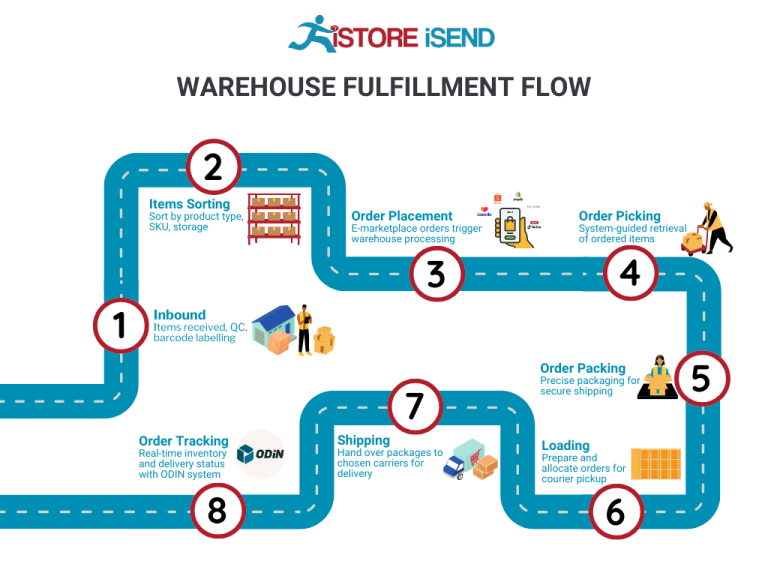
4. Order Packing
After items have been picked, they move to the packing stage, where products are carefully prepared for shipment. This process involves selecting appropriate packaging materials, such as boxes, bubble wrap, or thermal insulation for temperature-sensitive items. It is essential to pack items securely to prevent damage during transit and to include necessary documentation, such as packing slips or return labels.
The significance of order packing cannot be overstated; it plays a key role in maintaining product integrity and enhancing customer satisfaction. A well-packed order reflects a company’s attention to detail and commitment to delivering quality service. Additionally, optimizing packing processes can lead to cost savings by minimizing shipping dimensions and weight, which can reduce overall shipping costs.
5. Shipping & Delivery
The final step in the order fulfillment process is shipping and delivery. Once orders are packed, they are staged for dispatch. This phase often involves utilizing advanced logistics solutions to determine the most efficient delivery routes. Companies like Kroger leverage sophisticated algorithms and temperature-controlled vehicles to ensure timely and fresh delivery of groceries.
Shipping is a crucial component as it directly influences the customer’s experience. Timely delivery can enhance customer loyalty, while delays can lead to dissatisfaction. Moreover, effective tracking systems allow customers to monitor their orders in real-time, providing transparency and building trust. As e-commerce continues to evolve, optimizing shipping and delivery processes is vital for businesses looking to scale and maintain competitive advantages in the marketplace.
In conclusion, understanding and optimizing each step in the order fulfillment process is essential for e-commerce businesses aiming to enhance operational efficiency, reduce costs, and improve customer satisfaction. By paying careful attention to receiving, storage, picking, packing, and shipping, businesses can create a streamlined fulfillment operation that meets the demands of today’s consumers.

Comparing Fulfillment Models: In-House vs. 3PL vs. Dropshipping
Fulfillment Model Comparison
| Model | Who Handles Inventory | Best For (Business Stage) | Key Advantage | Key Disadvantage |
|---|---|---|---|---|
| In-House Fulfillment | The business itself | Established businesses scaling up | Complete control over inventory and processes | High overhead costs and resource demands |
| Third-Party Logistics (3PL) | A third-party logistics provider | Startups to mid-sized businesses | Scalability and reduced operational burden | Less control over inventory and processes |
| Dropshipping | Suppliers or manufacturers | New businesses or niche markets | Low startup costs and minimal risk | Lower profit margins and reliance on suppliers |
In-House Fulfillment
In-house fulfillment involves managing the entire inventory and shipping process internally. This model is typically best suited for established businesses that have reached a level of scale where they can effectively manage their own logistics. The primary advantage of in-house fulfillment is the complete control it offers over inventory management, order processing, and shipping procedures. Businesses can tailor their operations to meet customer needs, maintain quality control, and optimize their fulfillment processes for efficiency. However, this model comes with significant overhead costs, including warehousing, staffing, and technology investments. Additionally, in-house fulfillment requires a considerable amount of resources and expertise, which can strain small businesses or those just starting to scale.
Third-Party Logistics (3PL)
Third-party logistics (3PL) providers handle the storage, fulfillment, and shipping of products on behalf of businesses. This model is particularly advantageous for startups and mid-sized businesses that want to focus on core competencies like marketing and product development without the burden of managing logistics. 3PLs offer scalability, allowing businesses to adjust their logistics needs as they grow. They also provide access to advanced technology and logistics expertise that smaller businesses may not have in-house. However, using a 3PL means relinquishing some control over inventory and fulfillment processes, which can lead to challenges in maintaining brand consistency and customer experience. Businesses must also ensure they choose a reputable 3PL partner to avoid issues with order accuracy and delivery times.
Dropshipping
Dropshipping is a fulfillment model where businesses sell products without holding any inventory. Instead, when a customer makes a purchase, the order is forwarded to a supplier or manufacturer, who then ships the product directly to the customer. This model is ideal for new businesses or those targeting niche markets, as it requires minimal upfront investment and allows for quick entry into the market. The key advantage of dropshipping is the low financial risk; businesses are not burdened with unsold inventory or warehousing costs. However, dropshipping typically comes with lower profit margins due to the fees charged by suppliers, and businesses must rely heavily on their suppliers for order fulfillment and product quality. Additionally, the lack of control over inventory and shipping processes can lead to customer dissatisfaction if suppliers fail to meet expectations.
Conclusion
Choosing the right fulfillment model is crucial for e-commerce businesses looking to scale effectively. Each model—whether in-house fulfillment, 3PL, or dropshipping—offers distinct advantages and challenges that must align with the company’s operational capabilities, financial resources, and growth strategy. As businesses evaluate their options, they should consider their long-term goals, customer expectations, and the importance of maintaining control over their fulfillment processes. A thorough analysis of these factors will enable business owners to select a fulfillment model that not only meets their current needs but also supports their future growth aspirations.
A Deep Dive into Amazon FBA: Pros, Cons, and Who It’s For
Understanding Fulfillment by Amazon (FBA)
Fulfillment by Amazon (FBA) is a service offered by Amazon that allows sellers to store their products in Amazon’s fulfillment centers. Amazon then takes care of storage, packaging, and shipping, as well as customer service and returns for those products. This service enables sellers to leverage Amazon’s extensive logistics network and customer base, making it easier to scale their e-commerce operations.
How FBA Works
-
Setting Up FBA: Sellers begin by creating an Amazon seller account and enrolling in the FBA program. They can then list their products on Amazon and choose which items they want to fulfill through FBA.
-
Shipping Inventory to Amazon: Sellers must send their inventory to Amazon’s fulfillment centers. Amazon provides guidelines on how to prepare and package products for shipment.
-
Storage and Management: Once the products arrive at the fulfillment centers, Amazon takes over inventory management. Sellers can track their inventory levels through the Amazon Seller Central dashboard.
-
Order Fulfillment: When a customer places an order for a product fulfilled by FBA, Amazon picks, packs, and ships the item on behalf of the seller. Customers benefit from fast and reliable shipping options, often including same-day or two-day delivery.
-
Customer Service and Returns: Amazon also handles customer service inquiries and returns for FBA products, allowing sellers to focus on other aspects of their business.
Pros of Fulfillment by Amazon (FBA)
1. Prime Eligibility
One of the most significant advantages of FBA is that products fulfilled through this service are eligible for Amazon Prime. This means that Prime members can receive fast, free shipping on these items, which significantly increases the likelihood of purchases. Prime eligibility enhances product visibility and competitiveness.
2. Customer Trust
Amazon is a trusted brand, and customers often feel more comfortable purchasing products that are fulfilled by Amazon. The assurance of reliable shipping, customer service, and easy returns contributes to higher conversion rates for sellers.
3. Multi-Channel Fulfillment
FBA allows sellers to fulfill orders from multiple sales channels using Amazon’s logistics network. This means that sellers can use FBA for orders from their own websites or other platforms, consolidating their fulfillment processes and enhancing efficiency.
4. Increased Sales Potential
With access to Amazon’s vast customer base and the benefits of Prime eligibility, sellers using FBA often experience increased sales. The convenience of fast shipping can encourage more customers to complete their purchases.
5. Simplified Operations
FBA significantly reduces the burden of logistics for sellers. With Amazon handling storage, packing, shipping, and customer service, sellers can focus on product development and marketing rather than day-to-day fulfillment tasks.
Cons of Fulfillment by Amazon (FBA)
1. High Fees
One of the main drawbacks of FBA is the cost. Sellers incur various fees, including storage fees for inventory stored in Amazon’s warehouses and fulfillment fees based on the size and weight of the products. These costs can quickly add up, impacting profit margins.
2. Strict Inventory Rules
Amazon has strict policies regarding inventory management. Sellers must adhere to guidelines about storage limits, product condition, and labeling. Failure to comply can result in penalties or the inability to sell on Amazon.
3. Commingling Risks
FBA uses a commingling process where inventory from multiple sellers may be stored together. This can lead to issues if customers receive products that do not match the seller’s branding or quality. Furthermore, if a product is returned or damaged, it can be challenging to trace the issue back to the original seller.
4. Lack of Control
When using FBA, sellers relinquish a certain level of control over the fulfillment process. This includes how products are packaged and shipped, which may not align with the seller’s branding or customer experience goals.
5. Dependency on Amazon
Relying heavily on FBA can create a dependency on Amazon for sales and fulfillment. Changes in Amazon’s policies, fees, or algorithms can directly impact a seller’s business, making it essential to have a diversified sales strategy.
Who is FBA Best For?
Fulfillment by Amazon is particularly beneficial for:
-
Small to Medium-Sized Businesses: Companies that may not have the resources to manage their own fulfillment operations can leverage FBA to access Amazon’s logistics without significant upfront investment.
-
E-commerce Entrepreneurs: New sellers looking to quickly enter the market can utilize FBA to benefit from Amazon’s established infrastructure and customer trust.
-
Brands Seeking Scalability: Businesses that anticipate rapid growth can use FBA to scale their operations without the complexities of logistics management.
-
Sellers with High Turnover Products: Products that sell quickly and consistently are ideal for FBA, as sellers can benefit from the fast shipping and customer service that FBA offers.
In summary, while Fulfillment by Amazon provides numerous advantages that can streamline operations and enhance sales potential, sellers must also weigh the associated costs and risks. Understanding both the pros and cons is critical in determining if FBA aligns with your business strategy and goals.
Core Services Offered by Fulfillment Centers
Inventory Management & Warehousing
One of the fundamental services provided by fulfillment centers is inventory management and warehousing. This involves the systematic control of stock levels, ensuring that products are stored efficiently and accurately. Fulfillment centers utilize sophisticated inventory management systems that track products in real-time, allowing businesses to maintain optimal stock levels and reduce the risks of overstocking or stockouts.
Benefits: Effective inventory management leads to improved cash flow and reduced holding costs. By utilizing a fulfillment center, e-commerce businesses can access advanced analytics and reporting tools that provide insights into sales trends and inventory turnover rates. This enables business owners to make informed decisions regarding purchasing and inventory replenishment. Furthermore, centralized warehousing reduces the need for multiple storage facilities, which can significantly lower operational costs.
Pick and Pack Services
Pick and pack services are at the heart of fulfillment operations. This process involves selecting products from the warehouse based on customer orders (picking) and then packaging them for shipment (packing). Fulfillment centers typically employ automation and advanced picking technologies to enhance efficiency and accuracy in order fulfillment. This can include the use of robotics, conveyor systems, and real-time data tracking.
Benefits: The main advantage of pick and pack services is the speed and accuracy with which orders can be fulfilled. Customers expect fast delivery times, and a well-optimized picking process can significantly reduce the time it takes to prepare an order for shipment. Additionally, fulfillment centers often implement quality control measures to ensure that the correct items are packed, minimizing the likelihood of returns due to order errors. This enhanced customer satisfaction can lead to increased loyalty and repeat business.
Kitting and Assembly
Kitting and assembly services involve the grouping of various products into a single kit or the assembly of products before they are shipped to customers. This can include bundling items together for promotional offers, creating gift sets, or assembling components into a finished product. Fulfillment centers can handle these processes efficiently, allowing e-commerce businesses to offer more complex products without the need to manage the logistics of assembly themselves.
Benefits: Kitting and assembly services can provide a significant competitive advantage. By offering customized kits or assembled products, businesses can enhance their product offerings and create unique selling propositions. This service also helps streamline operations by reducing the time and resources needed to prepare products for sale. Additionally, it allows businesses to respond quickly to market demands and seasonal trends, as fulfillment centers can quickly adapt to changes in product offerings.
Returns Management (Reverse Logistics)
Returns management, often referred to as reverse logistics, is a critical service offered by fulfillment centers. This process involves handling returned items efficiently, including receiving, inspecting, restocking, or disposing of products. A robust returns management system is essential for maintaining customer satisfaction and managing the costs associated with returns.
Benefits: Effective returns management can significantly enhance customer trust and loyalty. By providing a straightforward and hassle-free return process, e-commerce businesses can mitigate the negative impacts of returns on customer experience. Fulfillment centers often have established procedures for handling returns, which can include automated systems for processing return requests and tracking returned items. This efficiency not only saves time but also reduces operational costs associated with managing returns in-house. Moreover, proper handling of returns can enable businesses to recover value from returned products, whether through resale, refurbishment, or recycling.
Conclusion
Utilizing fulfillment centers for these core services allows e-commerce businesses to scale their operations effectively while maintaining high levels of customer satisfaction. By outsourcing inventory management, pick and pack services, kitting and assembly, and returns management, businesses can focus on core activities such as marketing and product development. In today’s competitive market, leveraging the expertise and technology of fulfillment centers is essential for achieving operational efficiency and driving growth.
How to Choose a Fulfillment Partner: A 6-Point Checklist
Location & Warehouse Network
Why It Matters:
The geographical location of your fulfillment partner’s warehouses is crucial for ensuring timely deliveries and minimizing shipping costs. A strategically located fulfillment center can significantly reduce transit times, which is particularly important for perishable goods or high-demand items.
Questions to Ask:
– Where are your fulfillment centers located?
– How do you determine the best locations for your warehouses?
– Can you accommodate my target shipping regions effectively?
– What is your average delivery time to key markets?
– Do you have a plan for expanding your warehouse network in the future?
Technology & Integrations
Why It Matters:
Modern e-commerce relies heavily on technology for managing inventory, order processing, and logistics. A fulfillment partner that utilizes advanced technology can streamline operations, reduce errors, and enhance overall efficiency. Additionally, seamless integration with your existing systems (such as your e-commerce platform and inventory management) is vital for real-time tracking and data management.
Questions to Ask:
– What technology platforms do you use for order processing and inventory management?
– Can your systems integrate with my e-commerce platform (e.g., Shopify, WooCommerce)?
– Do you provide real-time tracking for both orders and inventory?
– How do you ensure data security and compliance with privacy regulations?
– What automation features do you offer that can improve efficiency?
Specializations (e.g., Cold Storage, Oversized Items)
Why It Matters:
Different businesses have unique needs based on their products. If you sell perishable goods, a partner with expertise in cold storage is essential. Similarly, if you deal with oversized items, you need a fulfillment center that can handle such products without additional costs or damages.
Questions to Ask:
– Do you have specialized facilities for handling my product type (e.g., cold storage, fragile items)?
– What are your procedures for maintaining product quality during storage and delivery?
– Can you manage the packaging and handling requirements specific to my products?
– What experience do you have with clients in my industry?
– Can you provide references from similar businesses you’ve worked with?
Scalability & Capacity
Why It Matters:
As your business grows, your fulfillment needs will change. A good fulfillment partner should have the capacity to scale operations to meet increasing demand without compromising service quality. This flexibility can save you from the headaches of switching partners as your business expands.
Questions to Ask:
– What is your current capacity for handling orders, and how do you manage peak seasons?
– How quickly can you scale operations if my order volume increases?
– What contingency plans do you have in place for unexpected surges in demand?
– Can you provide examples of how you’ve scaled for other clients in the past?
– How often do you assess and upgrade your facilities and technology to meet growing demands?
Pricing and Contracts
Why It Matters:
Understanding the cost structure of your fulfillment partner is essential for maintaining profitability. Hidden fees can significantly impact your margins, so it’s crucial to have a clear understanding of pricing models, contract terms, and any potential additional costs.
Questions to Ask:
– What pricing model do you use (e.g., per order, per item, flat fee)?
– Are there any hidden fees (e.g., for storage, picking, packaging)?
– What are the terms of your contracts, and do you offer flexibility for changes?
– How do you handle pricing during peak seasons or promotional events?
– Can you provide a detailed breakdown of estimated costs based on my expected order volume?
Customer Support & Reviews
Why It Matters:
Exceptional customer support is vital for resolving issues quickly and maintaining smooth operations. Additionally, reviews and testimonials can provide insights into a partner’s reliability and service quality.
Questions to Ask:
– What customer support options do you offer (e.g., phone, email, chat)?
– What are your response times for customer inquiries or issues?
– Can you share customer testimonials or case studies?
– How do you handle disputes or service failures?
– What measures do you have in place for continuous improvement based on customer feedback?
By thoroughly evaluating these six critical points, e-commerce business owners, operations managers, and entrepreneurs can make informed decisions when selecting a fulfillment partner. The right partner will not only enhance logistics efficiency but also contribute to a superior customer experience, ultimately supporting your business’s growth and success.
Understanding Fulfillment Pricing: A Breakdown of Common Fees
Initial Setup Fees
Initial setup fees are the charges associated with establishing an account with a fulfillment provider. These fees can vary widely based on the complexity of your operations and the specific services you require. Generally, they include costs for integrating your e-commerce platform with the fulfillment center’s systems, setting up inventory management tools, and any necessary training for your staff or the fulfillment center’s staff.
To calculate initial setup fees, fulfillment centers often consider factors such as:
– The number of products you plan to sell.
– The complexity of your inventory management needs (e.g., seasonal items, varying SKUs).
– Customization requests for packaging or branding.
It’s important to clarify what services are included in the setup fee and whether ongoing support will be provided.
Receiving Fees
Receiving fees are charges incurred when your products arrive at the fulfillment center. These fees cover the labor and resources required to unload, inspect, and store your inventory. The costs may vary based on the volume and type of goods being received.
Typically, receiving fees are calculated based on:
– The number of pallets or items received.
– The time taken to process the incoming inventory.
– Special handling requirements for fragile or perishable items.
Understanding how these fees are structured can help you manage your costs effectively, especially if you plan to ship large volumes of goods to the fulfillment center.
Storage Fees (per pallet/bin)
Storage fees are ongoing charges for keeping your inventory at the fulfillment center. These fees are usually assessed on a per pallet or per bin basis and can vary depending on the size and type of products stored.
Key factors influencing storage fees include:
– The duration of storage: Many fulfillment centers charge monthly fees, while some may offer discounts for long-term storage.
– The type of inventory: Perishable goods often incur higher fees due to the need for climate-controlled storage.
– Seasonal fluctuations: During peak seasons, such as holidays, storage fees may increase due to higher demand for warehouse space.
To minimize storage costs, it’s wise to implement efficient inventory management practices, ensuring that you only store what you need.
Pick & Pack Fees (per item/order)
Pick and pack fees are charges for the labor involved in retrieving items from storage and preparing them for shipment. This process typically includes picking the correct items, packing them into boxes, and labeling them for delivery.
These fees are usually calculated based on:
– The number of items in an order: More items result in higher fees.
– The complexity of packing: Special packaging requirements or kitting services can increase costs.
– Order frequency: Regular high-volume orders might qualify for reduced rates.
Understanding how pick and pack fees are structured can help you optimize your order management process and reduce overall fulfillment costs.
Shipping Fees
Shipping fees encompass the costs associated with transporting your products to customers. These fees can vary based on several factors, including the shipping method, package dimensions, weight, and destination.
Shipping fees are typically calculated based on:
– The shipping carrier’s rates: Different carriers have varying pricing structures based on speed and service level.
– Distance and delivery time: Longer distances and expedited services typically incur higher fees.
– Package weight and dimensions: Heavier or larger packages may attract additional surcharges.
To keep shipping costs manageable, explore multiple shipping options and negotiate rates with carriers when possible.
Tips for Getting an Accurate Quote
-
Provide Detailed Information: When requesting quotes, share comprehensive details about your products, order volumes, and expected growth. This will enable fulfillment centers to give you a more accurate estimate.
-
Ask About Hidden Fees: Inquire specifically about any additional charges that may not be immediately apparent, such as fees for returns, special handling, or seasonal surcharges.
-
Compare Multiple Providers: Don’t settle for the first quote you receive. Compare pricing, services, and customer reviews across multiple fulfillment providers to find the best fit for your business needs.
-
Negotiate Terms: Many fulfillment centers are open to negotiation, especially if you can provide a long-term volume commitment. Discuss potential discounts for higher volumes or early payment options.
-
Request a Trial Period: If possible, negotiate a trial period to evaluate the service without committing to a long-term contract. This can help you assess the efficiency and reliability of the fulfillment center.
By understanding the various fees involved in fulfillment pricing and how they are calculated, e-commerce business owners can make more informed decisions, ultimately leading to improved profitability and scalability.
Frequently Asked Questions (FAQs) about Fulfillment
1. What is the Kroger FC07 Fulfillment Center?
The Kroger FC07 Fulfillment Center, located in Aurora, Colorado, is a state-of-the-art facility designed to enhance Kroger’s grocery delivery capabilities. This center utilizes advanced robotics and automation technology developed in partnership with Ocado Group, allowing for efficient order processing and delivery of fresh groceries and essentials to customers in the Denver Metro area.
2. How does the Kroger FC07 Fulfillment Center operate?
The fulfillment center operates using a highly automated system where over 1,000 robots navigate a 3D grid called “The Hive.” This system efficiently picks and packs customer orders, ensuring high in-stock levels and timely deliveries. Orders are then transported in temperature-controlled vans to maintain product freshness during delivery.
3. What is the difference between a warehouse and a fulfillment center?
A warehouse primarily serves as a storage facility for goods, focusing on inventory management and bulk storage. In contrast, a fulfillment center is designed specifically for processing customer orders and ensuring fast delivery. Fulfillment centers typically have advanced technology to automate order picking, packing, and shipping, making them ideal for e-commerce operations.
4. What are the benefits of using a fulfillment center like Kroger FC07?
Using a fulfillment center like Kroger FC07 offers several advantages, including:
– Speed: Orders can be processed and delivered within a short time frame, often within 90 minutes.
– Freshness: Advanced cold chain solutions ensure that perishable items remain fresh during transportation.
– Scalability: Businesses can scale their operations without the need for significant upfront investment in warehousing and logistics infrastructure.
– Technology: Access to cutting-edge technology and automated systems enhances efficiency and accuracy in order fulfillment.
5. How much do fulfillment services cost?
Fulfillment service costs can vary widely based on several factors, including:
– Volume of Orders: Higher order volumes typically result in lower per-order costs due to economies of scale.
– Type of Products: Handling costs may differ for perishable items versus non-perishable goods.
– Service Level: Options for expedited shipping or specialized handling can increase costs.
On average, businesses can expect to pay anywhere from $2 to $10 per order, plus additional fees for storage, picking, and shipping.
6. What is a 3PL?
A 3PL, or third-party logistics provider, is a company that offers logistics services to businesses, including warehousing, transportation, and order fulfillment. By partnering with a 3PL, businesses can outsource their supply chain management, allowing them to focus on core operations such as sales and marketing.
7. How can businesses benefit from partnering with Kroger FC07?
Businesses can benefit from partnering with Kroger FC07 by leveraging its advanced fulfillment capabilities, extensive delivery network, and technology-driven solutions. This partnership can enhance customer satisfaction through quicker delivery times, access to fresh products, and improved inventory management, ultimately leading to increased sales and customer loyalty.
8. What areas does the Kroger FC07 Fulfillment Center serve?
The Kroger FC07 Fulfillment Center primarily serves the Denver Metro area, with the capability to deliver groceries and essentials to customers within a 90-minute radius. As demand grows, the center may expand its delivery zones to include additional ZIP codes.
9. How does Kroger ensure the quality of delivered products?
Kroger employs end-to-end cold chain solutions, including custom-built refrigerated vans, to maintain the quality and freshness of groceries during transit. The use of advanced technology and optimized delivery routes further ensures that products are handled with care and delivered promptly.
10. What job opportunities are available at the Kroger FC07 Fulfillment Center?
The Kroger FC07 Fulfillment Center currently employs over 200 associates, with plans to expand to more than 400 positions. Job opportunities include roles in order fulfillment, logistics, customer service, and management. Interested candidates can explore career options through Kroger’s official website.
Conclusion: Is Outsourcing Fulfillment the Right Move for Your Business?
Evaluating the Benefits of Outsourcing Fulfillment
Outsourcing your fulfillment operations can be a transformative decision for your e-commerce business. By leveraging a fulfillment service, you can unlock several key advantages that can significantly enhance your operational efficiency and customer satisfaction.
First and foremost, outsourcing fulfillment saves you valuable time. Managing logistics in-house requires extensive resources, from inventory management to shipping. By entrusting these responsibilities to a dedicated fulfillment partner, you can focus on core business functions such as marketing, product development, and customer engagement. This shift not only frees up your time but also allows for more strategic growth initiatives.
Scalability is another critical benefit. As your business grows, so do your fulfillment needs. A robust fulfillment partner can seamlessly scale operations to accommodate fluctuating order volumes, seasonal spikes, and geographical expansions. This flexibility ensures that your business can respond promptly to market demands without the burden of additional infrastructure costs.
Moreover, partnering with a fulfillment expert brings specialized knowledge and technology to the table. Fulfillment centers, like Kroger’s advanced Customer Fulfillment Centers, utilize cutting-edge technology, such as robotics and AI, to optimize inventory management and delivery processes. This expertise translates to improved accuracy, faster shipping times, and enhanced customer experiences.
However, the choice of fulfillment partner is crucial. Ensure that the service provider aligns with your business goals and has a proven track record of reliability and quality. A thorough evaluation of potential partners can pave the way for sustained growth.
Take Action
Now is the time to critically assess your current shipping and fulfillment processes. Conduct an audit to identify inefficiencies or bottlenecks that may be hindering your growth. Ask yourself: Is outsourcing fulfillment the right next step for my business? If so, begin exploring potential partners that can help elevate your operational capabilities and drive your success forward.
Important Disclaimer
⚠️ Important Disclaimer
The information in this guide is for educational purposes. Fulfillment services, pricing, and platform features change frequently. Always conduct your own due diligence and consult with providers directly before making business decisions.
